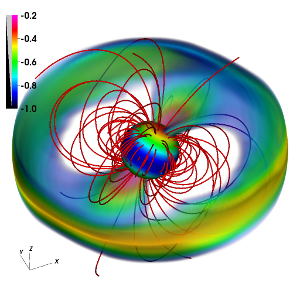 We present new results on the classical T Tauri star RU Lupi based on three observing runs collecting high-resolution spectra, complementary NIR spectra, multicolour photometric data, and X-ray observations. The photospheric absorption lines are weakened. This veiling becomes extremely strong on occasion, and we show that this effect is due to narrow emission lines that fill in the photospheric lines. The blue-shifted wings in the optical emission lines of He I, attributed to a stellar wind, are remarkably stable in equivalent width. In contrast, the red-shifted wings change dramatically in strength depending on rotational phase. From the pattern of variability we infer that these wings originate in accreting gas close to the star, and that the accretion funnels are bent and trail the hot spot. Forbidden emission lines are very stable over the entire observing period and originate in the disk wind. A system of narrow blue-shifted absorption features seen in lines of Ca II and Na I can be traced to a disk wind as well. Slightly blue-shifted emission components are present in the forbidden lines and might be related to a wide angle molecular disk wind.
We present new results on the classical T Tauri star RU Lupi based on three observing runs collecting high-resolution spectra, complementary NIR spectra, multicolour photometric data, and X-ray observations. The photospheric absorption lines are weakened. This veiling becomes extremely strong on occasion, and we show that this effect is due to narrow emission lines that fill in the photospheric lines. The blue-shifted wings in the optical emission lines of He I, attributed to a stellar wind, are remarkably stable in equivalent width. In contrast, the red-shifted wings change dramatically in strength depending on rotational phase. From the pattern of variability we infer that these wings originate in accreting gas close to the star, and that the accretion funnels are bent and trail the hot spot. Forbidden emission lines are very stable over the entire observing period and originate in the disk wind. A system of narrow blue-shifted absorption features seen in lines of Ca II and Na I can be traced to a disk wind as well. Slightly blue-shifted emission components are present in the forbidden lines and might be related to a wide angle molecular disk wind.
Authors: Gösta F. Gahm, Henricus C. Stempels, Frederick M. Walter, Peter P. Petrov, Gregory J. Herczeg

